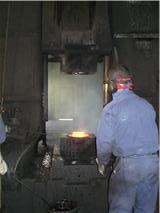This is “The Business Plan”, chapter 5 from the book Modern Management of Small Businesses (v. 1.0). For details on it (including licensing), click here.
For more information on the source of this book, or why it is available for free, please see the project's home page. You can browse or download additional books there. To download a .zip file containing this book to use offline, simply click here.
Chapter 5 The Business Plan
Consolidated Industries’ Hammer Forge

Source: Used with permission from Consolidated Industries.
Consolidated Industries represents one of the thousands of small manufacturers that exist throughout the United States. It has been in business for more than sixty years, specializing in the forging of ferrous, nonferrous, and exotic materials. Its prime customer base has been the aerospace industry, but it has also expanded into other industrial customers.
Originally a family business, Consolidated Industries was sold to new owners in 1999. Once the owner reached retirement age, his children, a brother and sister, found it difficult to agree on the future direction of the company. This period of confusion was made more difficult when the head of sales died. Competitors exploited this situation. The new CEO—John Wilbur—immediately recognized that there had been some complacency about generating new customers, and the firm would not be able to survive in the long run merely on its backlog of orders. Wilbur began to aggressively deal with the firm’s problems and build its customer base. In ten years, he was able to take Consolidated Industries’ sales from $8 million a year to $30 million a year. He attributes much of this success to the firm’s commitment to business planning.
Soon after taking over the business, he started a comprehensive planning process. Given the pressing issues the firm was facing, the first plan had a one-year horizon. It was instrumental in gaining the support of Consolidated Industries’ bankers, which carried it through those difficult years. In the intervening years, the plan’s horizon was expanded to five years. Although Wilbur admitted that the projections may be “pipe dreams” after the first two years, he said it was important to maintain the five-year horizon to force the business to think about the future. The main goals of the plan had been to examine ways to lower costs and expand the customer base, particularly outside the aerospace industry.
The plan would be constantly evolving; detailed metrics would provide guidance to the various units throughout the firm. These metrics were broken down on a quarterly basis and were color coded to allow the various units to see how well they were progressing toward the achievement of the goals and the objectives. It had a detailed sales plan that emphasized developing new customers in new industries. To this end, it significantly focused on developing new products. In the past few years, the number of new products increased from six per year to seventy-seven per year. This meant an enlargement of the engineering staff, but it is also meant a much closer relationship with customers. Wilbur estimated that 50 percent of the new products were a codesign with customers. The planning process also enabled the business to incorporate technology in new ways. The firm used videoconferencing to communicate with both customers and sister units. Another important element of the plan was the concept of succession planning. As vital as the planning process was, Wilbur said that “it is all about people. Any plan to improve the firm has to bring people into the process and bring them together.”




